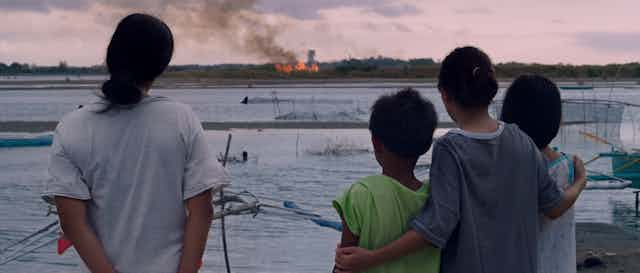For an expectant crowd of cinephiles sitting down to see a four-hour film, it is easy enough to identify with Fabian, the main character of Norte, the End of History, that screened at the Melbourne International Film Festival. Fabian is a young student in the midst of a growing existential malaise. He drops out of university to just live in his own idealistic way.
Given the grim events that dominate news headlines today, the despondency that creeps into Fabian’s otherwise privileged life as a gifted law student in Laoag City, located in the Ilocos Norte province of the Philippines, is intoxicating.
What makes the celebrated Filipino director Lav Diaz’s 250-minute epic so hard to bear is that our protagonist begins to spiral beyond his comfortable armchair philosophising with his beer buddies – and resolves to take his romantic student politics into everyday life. This leads him, almost an hour into the film, to brutally murder his local money-lender. In the act he confronts the unlikeable woman in her home and stabs her to death in front of her young daughter – whom he also murders on an impulse as a witness to the crime.
For the remainder of the film, Fabian’s commitment to acting out his increasingly radical beliefs exposes the futility of his righteous actions. Fabian’s character stands in contrast to Joaquin, whose partner Eliza struggles with their debt while he recovers from a leg injury.
After farcically attacking Magda the moneylender from his crutches, it is Joaquin who is accused of the murder. Speechlessly, the labourer accepts making a guilty plea for a crime we know he didn’t commit. Throughout the film a faceless justice system administers impenetrable social control. Accepting a life in prison, his sentence is ameliorated only by the fact that the rooms we see in residential buildings do not differ greatly from the stifling atmosphere of the prison’s interior.
The cinema of Lav Diaz
A mature writer and director, Diaz has made 15 films since 1998, including the eight-hour survey of existential desolation in Filipino life, Melancholia (2008). He is known for his commitment to an editorial style that attempts to capture real moments of lingering and banal social interactions which expose the extreme situations of contemporary life.
Norte screened at the Un Certain Regard section of the 2013 Cannes Film Festival and has since received glowing praise.
What’s rarely noted in mainstream press, however, is the violence inflicted on almost all of the women in the film. The woman as victim, as the helpless subordinate, is a figure repeated here again and again, to the point of producing our disgust.
Diaz’s critique of the mythology of the West is clearly marked. Signifiers of western culture make constant appearances throughout the film.
Fabian is reading Norman Mailer and the Marquis de Sade. He discusses missionary philosopher Derek Parfit with his ever-encouraging law teachers. Meanwhile, the prisons are labelled with English-language imperatives such as “visitor meeting point”. The Tagalog dialogue frequently breaks into English catchphrases – and Fabian finds work for a time in an American-style diner in Manila staffed with born-again Christians.
Who has the time?
The brutal symmetry of the time-rich audience, who can afford to sit down to enjoy a 250-minute film in a cinema matches only too well with Fabian’s student life. Long, idle periods are made available in which to ponder the state of the world. By contrast, Eliza and her family work long days at the margins of a society in which there’s an entrenched gap between the poor and the wealthy. This is the central conceit of the film.
The contrast reinforces the polarising dynamic between Fabian, the demonised intellectual and Joaquin, the angelic and redemptive hero. Ultimately Diaz’s film is a thorough and sincere lamentation on the fatalism of a post-colonial world. The children who grow up into this situation are already orphaned by the system they have inherited.
There is a line from Fyodor Dostoyevsky’s novel Crime and Punishment, that’s been etched into my memory and upon which Diaz’s film has been loosely adapted from: “We’ve got all the time in the world,” says the investigator Porfiry to the villain Raskolnikov, caught in the excruciating deferral of his fate. Similarly, in Diaz’s strong-arm character, Wakwak – a prison heavy who brutalises Joaquin and the other prisoners – as the literal manifestation of the film’s dystopian psychodrama, the end of history is the end of a form of life.
Modernity, patriarchy, social organisation and domination, are all placed in crises by the broken philosophies that undermine this image of Filipino society. The barbarity of this contemporary breakdown reinstates all horrors of the epoch. Diaz’s characters are cut adrift from all the once-stabilising structures such as law, justice, civility. Their world is defined by dollar value.
In a four-hour long film, we have all the time in the world to consider this misogyny and misanthropy, and pathos – realised as a despairing result of one reading of the despotic conditions reappearing under late capitalism, or, the end of history.
The Melbourne International Film Festival 2014 runs until Sunday August 17. See all MIFF 2014 coverage on The Conversation here.

